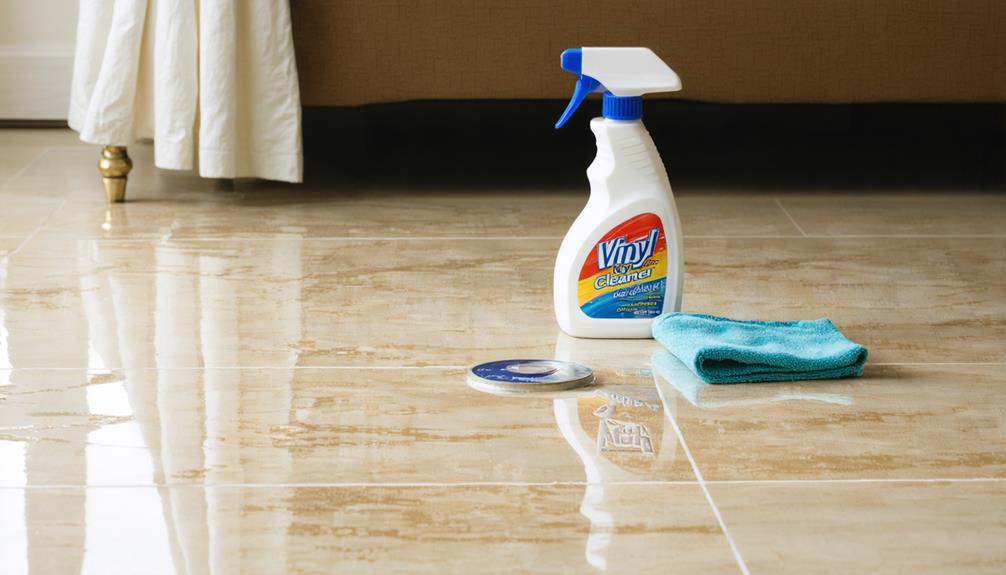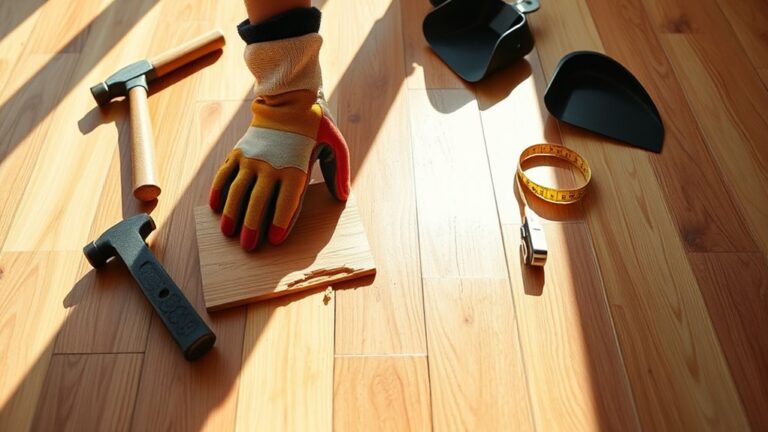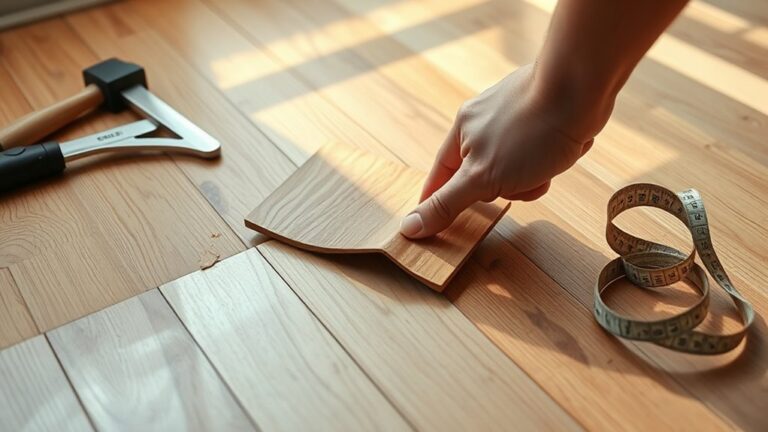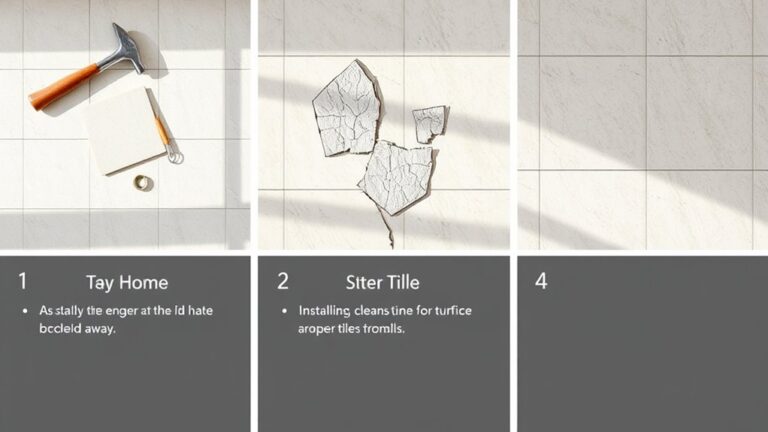To repair scratches on vinyl floors, start by evaluating the scratch's severity. For light scratches, buff the area with a scouring pad or use a scratch concealer. Deeper gouges may require fine-grit sandpaper followed by wax or clear lacquer application. Clean the surface with a dish soap and water solution before making repairs. Applying a thin layer of paste wax can enhance shine and fill minor scratches. Consider using repair kits for color matching and additional materials. With proper maintenance, you'll keep your floors looking their best, and there's more effective techniques to explore for long-term care.
Overview of Vinyl Flooring
Vinyl flooring, a popular choice for many households and businesses, is known for its durability and moisture resistance. Invented in 1920 by Waldo Semon, vinyl flooring is primarily made from plasticized polyvinyl chloride (PVC), which combines ethylene and chlorine. This unique composition allows it to withstand significant wear and tear, making it a practical option for high-traffic areas.
Cost-effectiveness is another reason vinyl flooring has gained popularity. It offers an appealing aesthetic that can mimic natural materials at a fraction of the cost. Maintenance is also straightforward, requiring basic cleaning to keep the surface looking fresh. However, it's essential to recognize that while vinyl is resilient, it can still be prone to scratches, cracks, and buckling, particularly in environments where heavy furniture is dragged or where moisture is improperly managed. Regular upkeep is necessary to maintain its visual appeal and prolong its lifespan.
Additionally, vinyl flooring is environmentally friendly, as it is recyclable and relies on limited natural resources. This aspect aligns with the increasing demand for sustainable flooring solutions. However, proper installation is vital; using incorrect techniques can lead to further damage and compromise the flooring's integrity over time. If you're considering vinyl flooring for your space, remember that professional installation can help prevent future issues and guarantee you enjoy its benefits to the fullest. With the right care, vinyl flooring can remain a stylish and durable choice for years to come.
Importance of Preventive Measures
Preventive measures play an essential role in maintaining the appearance and longevity of your vinyl flooring. By taking proactive steps, you can considerably reduce the risk of scratches and other types of damage that can mar its beauty. One effective way to prevent damage is by attaching felt pads under furniture legs. These floor protectors create a barrier that minimizes friction when items are moved, preserving the integrity of your vinyl.
Additionally, placing area rugs in high-traffic zones can serve as a protective layer, safeguarding against dirt and moisture that contribute to wear over time. Regular sweeping and cleaning are essential as well; by keeping dirt buildup at bay, you can avoid scratches and maintain a pristine look. It's also important to educate everyone in your household about proper care practices. For instance, discourage them from dragging heavy objects across the floor, as this can lead to considerable damage.
Utilizing doormats at entry points is another strategic move to protect your flooring. They effectively catch dirt and moisture before it reaches your vinyl, reducing the likelihood of scratches and preserving its appearance. By adopting these preventive measures, you're not just prolonging the life of your vinyl flooring; you're also ensuring that it remains a beautiful and functional part of your home. Taking these simple steps can save you time and money in the long run, allowing you the freedom to enjoy your space without worry.
Assessing Scratch Severity
To effectively assess scratch severity on your vinyl floor, start by identifying the type and measuring the depth and width of each scratch. If your fingernail catches in the scratch, it indicates a deeper gouge that may require specialized repair. Understanding these factors will help you choose the most appropriate repair approach, whether it's a simple DIY fix or a call for professional help.
Identifying Scratch Types
How can you effectively assess the severity of scratches on your vinyl floors? Start by identifying the type of scratches you're dealing with. You'll generally encounter two categories: shallow surface scratches and deeper scratches. Shallow scratches, often seen as minor blemishes, typically only affect the surface layer of your flooring. These are usually easy to remediate with simple DIY methods like buffing or applying wax.
Next, evaluate medium-depth scratches, which might require a bit more elbow grease. You can often tackle these with a baking soda paste or gentle sanding to restore the floor's appearance. Pay attention to how the scratch feels and looks; if it's still smooth to the touch but visible, it's likely shallow or medium-depth.
On the flip side, if you notice deep scratches or gouges that penetrate through to the backing, you're facing extensive damage. In such cases, it's wise to seek professional assistance or consider replacing the affected vinyl plank. By accurately identifying the type and severity of scratches, you can choose the most effective repair method, ensuring your floors regain their former beauty.
Depth and Width
After identifying the types of scratches on your vinyl floors, it's important to evaluate their depth and width. Start by visually inspecting the scratches; categorize them into three severity levels: light (surface scratches), medium (slight gouges), and deep (significant damage). This classification helps you determine the appropriate repair methods.
Next, measure the width of each scratch. Narrow scratches can often be concealed effectively with a scratch concealer, while wider scratches may require repair kits or possibly professional services. To gauge the depth, perform the fingernail test. If your fingernail catches on the scratch, it indicates a deeper issue that may need professional intervention.
Document each scratch's severity as you evaluate them. This record will guide you in deciding whether DIY fixes are feasible or if you should seek out a professional service. Remember, shallow scratches typically affect only the surface layer of vinyl, while deeper scratches can penetrate through multiple layers, complicating the repair process. By accurately evaluating the depth and width of the scratches, you can make informed choices about how to restore your vinyl flooring effectively.
Recommended Repair Approaches
While evaluating the severity of scratches on your vinyl floors is essential for determining the right repair approach, understanding the appropriate methods for each category of damage is equally important. Start by examining the depth and width of the scratches. If a scratch only affects the surface layer, you can often fix it easily with light buffing or a scratch concealer from a scratch repair kit. These options are straightforward and require minimal effort.
However, for deeper gouges that penetrate into the vinyl, you'll need to adopt a more robust strategy. Using fine-grit sandpaper can help smooth out the damaged area, followed by the application of a wax or lacquer to restore the floor's appearance.
Additionally, consider the scratch's location; those in high-traffic areas may demand more durable repair techniques than those in less visible spots. Documenting the condition of your flooring before starting repairs can also guide your approach, ensuring you choose the best method to fix scratches while maintaining long-term integrity. Ultimately, knowing how to properly examine scratch severity will empower you to select effective repair solutions tailored to your needs.
DIY Repair Techniques
Repairing scratches on vinyl floors can be a straightforward process with the right techniques. For minor scratches, grab a scouring pad and buff the affected area gently. This helps to smooth out the imperfections. Once you've buffed the scratch, apply a thin layer of paste wax to enhance the finish and provide a protective layer.
If you're dealing with deeper scratches, you'll want to use a scratch concealer. Before application, make sure the area is clean and dry for ideal adhesion. A mixture of dish soap and warm water works well to thoroughly clean the surface, ensuring any dirt or grime won't interfere with your repair.
Another effective method is to use car wax. Apply it in circular motions over the scratched area. This not only fills in minor scratches but also restores the floor's shine, making it look as good as new.
To minimize future scratches on your vinyl floors, consider using felt floor protectors under furniture legs. This simple step can save you from more repair work down the line. Additionally, placing area rugs in high-traffic zones can greatly reduce wear and tear.
Using Repair Kits
When it comes to addressing scratches on vinyl floors, using a repair kit can be an effective and efficient solution. These kits typically provide everything you'll need for a successful DIY repair, especially for those deep scratches that can be a real eyesore. By opting for a repair kit, you not only save money compared to hiring professionals but also gain the satisfaction of performing the repair yourself.
Here are some essential components you can expect in a typical vinyl floor repair kit:
- Backing Fabric: Provides support for the repair, guaranteeing durability.
- Colorant: Helps achieve the correct shade to match your flooring.
- Clear Lacquer: Seals the repair, adding protection and shine.
- Detailed Instructions: Guides you through the application process step-by-step.
- Online Resources: Offers additional support and tips for best results.
Choosing the right repair kit is vital. Make sure it's compatible with your specific type of vinyl flooring to guarantee the best outcomes. Most kits are designed for color matching and material consistency, which makes it easier to blend the repair with the existing floor.
Professional Repair Options
For those looking to restore their vinyl floors to pristine condition, professional repair options offer a dependable solution. Professional repair services, such as Creative Colors International (CCI), specialize in vinyl floor restoration and can effectively address a variety of issues, including peeling, fading, and deep scratches. By hiring skilled technicians equipped with the right tools and expertise, you can save considerably—up to 95%—compared to the cost of a full flooring replacement.
One of the advantages of these services is the mobile repair option, allowing professionals to perform repairs on-site. This minimizes disruption to your business operations and guarantees convenience, letting you maintain your daily activities with minimal interruptions. The all-encompassing nature of these services typically includes scratch repairs, as well as treatment for stains and discoloration, enhancing the overall aesthetic of your flooring.
Flexible scheduling is often available, making it easier to accommodate your needs and reduce downtime during repairs. Whether you're dealing with minor scratches or more substantial damage, professional repair options provide a practical pathway to rejuvenate your vinyl flooring. By investing in vinyl floor restoration through trusted services, you can regain the beauty and functionality of your floors without the hassle of a complete overhaul. Embrace the freedom and efficiency that professional repairs can bring to your space, guaranteeing your vinyl floors look as good as new.
Cleaning Before Repairs
Thoroughly cleaning your vinyl floor before any repair work is essential for achieving ideal results. If you skip this step, dirt and debris can interfere with the repair process, affecting adhesion and finish. To guarantee a successful repair, follow these steps for cleaning the vinyl floor properly:
- Mix a quarter cup of dish detergent in a bucket of warm water to create an effective cleaning solution.
- Use a sponge or soft cloth to scrub the floor, focusing on removing scuff marks and stains.
- Rinse the sponge or cloth frequently to prevent redistributing grime back onto the floor.
- After cleaning, allow the floor to dry completely; moisture can hinder the effectiveness of your repair materials.
- Consider regular deep cleaning as part of your maintenance routine to enhance the floor's appearance and longevity, preventing further damage.
Waxing for Shine
Waxing your vinyl floors not only revitalizes their shine but also creates a protective barrier against future damage. To achieve the best results, it's important to apply the wax using specific techniques and select high-quality products designed for vinyl surfaces. This process will enhance the overall appearance of your floors while prolonging their lifespan.
Benefits of Waxing
A well-executed waxing process can greatly enhance the appearance and longevity of your vinyl floors. By regularly waxing, you not only achieve a glossy finish but also create a protective barrier that helps keep scratches out of vinyl. This simple yet effective method can save you both time and money while ensuring your floors look their best.
Here are some key benefits of waxing your vinyl floors:
- Enhanced Shine: Waxing restores the floor's luster, making it visually appealing.
- Scratch Protection: A layer of wax fills in minor scratches and imperfections, resulting in a smoother surface.
- Cost-Effective Maintenance: Regular waxing reduces the need for frequent professional cleaning services, saving you money over time.
- Quick Process: Waxing is a fast DIY task that requires minimal supplies, making it accessible for anyone.
- Improved Aesthetics: Consistent waxing maintains your flooring's appeal, positively impacting first impressions in commercial settings.
Wax Application Techniques
Maintaining the shine of your vinyl floors goes beyond just regular waxing; it involves mastering the application techniques for ideal results. Start by selecting a quality car wax, known for its ability to fill scratches and provide a protective layer. Use a clean rag and apply the wax in circular motions, focusing on the scratched area. This technique guarantees the scratch is filled completely, creating an even finish.
Once you've covered the scratched area, carefully wipe away any excess wax from surrounding areas to prevent a cloudy appearance. This step is vital, as excess wax can detract from the overall look of your floor. After application, allow the wax to dry thoroughly—this typically takes about 10-15 minutes. Walking on the floor before it's dry can lead to smudging and diminish the shine you've worked to achieve.
Regularly practicing these wax application techniques will not only enhance the aesthetic appeal of your vinyl flooring but also contribute to its longevity and resistance to everyday wear and tear. Embrace these methods, and your floors will reflect the care you put into maintaining them.
Recommended Wax Products
When it comes to selecting the right products for restoring shine to your vinyl floors, opting for a high-quality paste wax specifically formulated for vinyl is vital. This choice not only enhances the floor's gloss but also helps protect the surface from future scratches. Here are some recommended wax products that can aid in achieving ideal results:
- Vinyl Floor Paste Wax: Designed specifically for vinyl, guaranteeing compatibility and effectiveness.
- Car Wax: An excellent buffing agent; apply it in circular motions to fill scratches and enhance appearance.
- Microfiber Cloths: Use these for application and buffing; they prevent scratching during the process.
- Floor Polish: Some products combine wax and polish, offering dual benefits for shine and protection.
- Manufacturer-Specific Wax: Always consult your floor's manufacturer for recommended wax products to ascertain the best compatibility.
Regular waxing is vital; it not only maintains your flooring's gloss but also greatly prolongs its life by providing a protective barrier. Be sure to follow the manufacturer's instructions for each product to maximize your results.
Long-term Care Tips
To keep your vinyl floors looking pristine and to extend their lifespan, regular care is vital. Start by sweeping or vacuuming your floors frequently to prevent dirt and debris buildup. This step is essential, as accumulated grime can scratch the surface and dull its finish over time. For deeper cleaning, mop your floors every few weeks using a mixture of mild dish soap and warm water. Be cautious to avoid harsh chemicals, as these can damage the vinyl and compromise its integrity.
Consider placing felt pads under the legs of your furniture and using area rugs in high-traffic zones. This simple act can greatly reduce the risk of scratches and wear on your flooring, thereby enhancing its durability. If you notice any scratches or damage, address them promptly using DIY methods or, if necessary, professional floor repair services. Timely intervention is key to maintaining your floor's aesthetic appeal.
Additionally, scheduling routine inspections of your vinyl flooring is a wise practice. By identifying and addressing emerging issues early, you can prevent them from escalating into substantial damage. These long-term care tips not only maintain the beauty of your floors but also protect your investment. By committing to this maintenance routine, you'll guarantee your vinyl floors remain in excellent condition for years to come. Remember, a little attention goes a long way in preserving the quality and longevity of your flooring.
Summary of Repair Steps
Repairing scratches on vinyl floors can seem challenging, but following a systematic approach makes it manageable. By adhering to these steps, you'll efficiently tackle scratches and maintain your flooring's appearance:
- Clean the Area: Start by using a mixture of dish soap and warm water. Thoroughly clean the scratched area to remove dirt or grease, guaranteeing a proper foundation for repair.
- Buff Minor Scratches: For minor scratches, gently buff the area with a scouring pad. This can help smooth out the surface before applying any protective product.
- Apply Paste Wax: After buffing, apply paste wax to restore shine and protect the surface. This step is essential for minor scratches.
- Use Scratch Concealer for Deeper Scratches: If you're dealing with deeper scratches, make sure the area is dry and clean before applying a scratch concealer. Buff the area with a soft cloth until smooth for ideal results.
- Consider a ScratchFix Kit: For a thorough repair, utilize a ScratchFix Kit which includes a scratch removal pen and repair spray tailored for various vinyl flooring types.
Frequently Asked Questions
Can You Fix Scratches on Vinyl Flooring?
Yes, you can fix scratches on vinyl flooring. Start by cleaning the area with a mix of dish detergent and warm water to prep for repair. For scratch prevention, consider applying a protective sealant. Regular vinyl maintenance helps prolong the floor's lifespan. If the scratches are deeper, use a vinyl repair kit for color matching and thorough coverage. Remember, keeping your floors clean and using furniture pads can minimize future damage.
How Do You Repair Gouges in Vinyl Flooring?
To tackle gouge repair in vinyl flooring, start by cleaning the affected area to guarantee it's dirt-free and dry. For deeper gouges, you'll need a repair kit that includes backing fabric, colorant, and clear lacquer. Position the backing fabric under the gouge, apply the colorant to match the vinyl, and seal it with clear lacquer for a smooth finish. For less severe gouges, a clear acrylic lacquer can help blend the edges into the surrounding area.
How to Get Scuff Marks off Vinyl Flooring?
To get scuff marks off your vinyl flooring, you can use several effective cleaning techniques. Start with a mix of warm water and dish soap, scrubbing gently with a soft cloth. For tougher marks, try a baking soda paste or a magic eraser. If they're persistent, a few drops of mineral oil can break down residue. Remember, regular maintenance tips, like avoiding abrasive cleaners, will help keep your floors looking great.
How to Fix Deep Scratches on Laminate Flooring?
When it comes to deep scratches on laminate flooring, it feels like a wound on a pristine canvas. For effective deep scratch removal, start by cleaning the area thoroughly. Then, use a repair kit featuring colorant and clear lacquer for a seamless blend. If the damage is extensive, consider wood filler or epoxy, allowing it to cure before sanding. Always test colorants in an inconspicuous spot to guarantee proper laminate flooring care.




